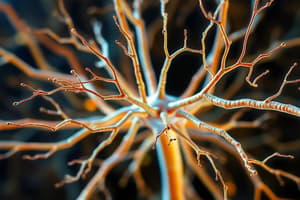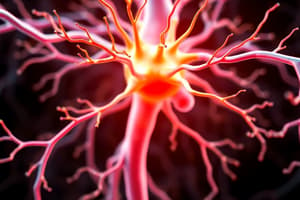Podcast
Questions and Answers
What is acetylcholine?
What is acetylcholine?
- A glial cell
- A part of the spinal cord
- A neurotransmitter (correct)
- A type of nerve cell
An __________ nerve carries messages toward the brain and spinal cord.
An __________ nerve carries messages toward the brain and spinal cord.
afferent
What is the function of the arachnoid membrane?
What is the function of the arachnoid membrane?
It is the middle layer of the three membranes that surround the brain and spinal cord.
Astrocytes are types of glial cells that transport water and salts from capillaries.
Astrocytes are types of glial cells that transport water and salts from capillaries.
What does the autonomic nervous system control?
What does the autonomic nervous system control?
What is the role of an axon?
What is the role of an axon?
The blood-brain barrier allows all substances to penetrate the blood capillary walls.
The blood-brain barrier allows all substances to penetrate the blood capillary walls.
What is the brainstem?
What is the brainstem?
The ________ equina is a collection of spinal nerves below the end of the spinal cord.
The ________ equina is a collection of spinal nerves below the end of the spinal cord.
What does the central nervous system consist of?
What does the central nervous system consist of?
Define the role of the cerebellum.
Define the role of the cerebellum.
The ________ cortex is the outer region of the cerebrum.
The ________ cortex is the outer region of the cerebrum.
What does cerebrospinal fluid circulate throughout?
What does cerebrospinal fluid circulate throughout?
The vagus nerve is the twelfth cranial nerve.
The vagus nerve is the twelfth cranial nerve.
What does the medulla oblongata control?
What does the medulla oblongata control?
Which layer of the meninges is the thickest?
Which layer of the meninges is the thickest?
What is the function of glial cells?
What is the function of glial cells?
A __________ is a collection of nerve cell bodies in the peripheral nervous system.
A __________ is a collection of nerve cell bodies in the peripheral nervous system.
Motor nerves carry messages toward the brain.
Motor nerves carry messages toward the brain.
What is the myelin sheath?
What is the myelin sheath?
The part of a nerve cell that contains the nucleus is called the __________.
The part of a nerve cell that contains the nucleus is called the __________.
Neuropathy refers to diseases of the central nervous system.
Neuropathy refers to diseases of the central nervous system.
What is sciatica?
What is sciatica?
What condition does hyperesthesia refer to?
What condition does hyperesthesia refer to?
The term __________ refers to inflammation of the nerve root.
The term __________ refers to inflammation of the nerve root.
Hemiplegia affects both sides of the body.
Hemiplegia affects both sides of the body.
Define paralysis.
Define paralysis.
Flashcards are hidden until you start studying
Study Notes
Key Terms and Definitions
- Acetylcholine: Neurotransmitter that transmits signals between nerve cells.
- Afferent Nerve: Nerve that carries sensory information to the brain and spinal cord.
- Arachnoid Membrane: Middle layer of the meninges surrounding the brain and spinal cord.
- Astrocyte: Glial cell that transports nutrients from blood vessels to neurons.
- Autonomic Nervous System: Regulates involuntary functions like heartbeat and digestion.
- Axon: Fiber that conducts electrical impulses away from the nerve cell body.
- Blood-Brain Barrier: Protective barrier between the brain and bloodstream preventing harmful substances from entering.
- Brainstem: Connects the brain and spinal cord; contains vital centers for basic life functions.
- Cauda Equina: Bundle of spinal nerves located below the spinal cord termination.
- Cell Body: Contains the nucleus and is essential for nerve cell function.
- Central Nervous System (CNS): Comprises the brain and spinal cord.
- Cerebellum: Coordinates balance and motor activity; located at the back of the brain.
- Cerebral Cortex: Outer layer of the cerebrum involved in high-level functions like perception and voluntary action.
- Cerebrospinal Fluid (CSF): Circulates, protecting and nourishing the brain and spinal cord.
- Cerebrum: The largest brain part, key for voluntary actions and cognitive tasks.
- Cranial Nerves: Twelve pairs of nerves, primarily serving the head and neck.
- Dendrite: Receives electrical signals from other neurons.
- Dura Mater: Tough outer membrane of the meninges.
- Efferent Nerve: Carries commands from the brain/spinal cord to muscles/organs.
- Ependymal Cell: Lines cavities in the CNS and helps produce CSF.
- Ganglion: Nerve cell body cluster in the peripheral nervous system.
- Glial Cells: Supportive cells in the nervous system that help maintain homeostasis and support neurons.
- Gyrus: Raised convolutions of the cerebral cortex.
- Hypothalamus: Regulates crucial involuntary functions including temperature and appetite.
- Medulla Oblongata: Controls autonomic functions like respiration and heart rate.
- Meninges: Tri-layered protective membranes of the brain and spinal cord.
- Microglial Cell: Acts as a scavenger, removing waste in the CNS.
- Motor Nerve: Transmits signals from the CNS to muscles for action.
- Myelin Sheath: Insulating layer around axons that increases the speed of nerve impulse conduction.
- Nerve: Bundle of axons that transmits signals throughout the body.
- Neurotransmitter: Chemical messengers that transfer signals across synapses; examples include dopamine and serotonin.
- Oligodendroglial Cell: Forms myelin sheath in the CNS.
- Parasympathetic Nerves: Regulate bodily functions at rest.
- Peripheral Nervous System: Comprises all nervous tissue outside the CNS.
- Pia Mater: Delicate inner membrane covering the brain and spinal cord.
- Plexus: Network of interwoven nerves.
- Pons: Connects and relays signals between different parts of the brain.
- Receptor: Tissue that receives and transmits stimuli to sensory nerves.
- Sciatic Nerve: Major nerve of the leg originating from the lower back.
- Sensory Nerve: Carries impulses to the CNS from sensory receptors.
- Stimulus: Any change that can provoke a response from the nervous system.
- Stroma: Supporting tissue in organs, including the CNS.
- Sulcus: Grooves in the cerebral cortex that separate gyri.
- Sympathetic Nerves: Activate the fight or flight response.
- Synapse: Junction between nerve cells where impulses are transmitted.
Related Disorders
- Anesthesia: Loss of sensation, often induced for medical procedures.
- Neuropathy: General term for nerve disorders; can affect various functions.
- Radiculopathy: Condition affecting nerve roots, leading to pain or numbness.
- Spina Bifida: Congenital defect from incomplete closure of the spinal column.
- Hydrocephalus: Condition where excess cerebrospinal fluid accumulates in the brain.
- Epilepsy: Neurological disorder causing recurrent seizures.
- Aphasia: Language impairment affecting speech production or comprehension.
- Coma: Unresponsive state due to brain dysfunction; inability to be awakened.
Pain and Sensation
- Analgesia: Absence of pain.
- Hyperalgesia: Increased sensitivity to pain.
- Paresthesia: Abnormal sensations like tingling or "pins and needles."
- Dysesthesia: Unpleasant abnormal sensation.
Movement Disorders
- Ataxia: Lack of coordination during voluntary movements.
- Dyskinesia: Involuntary movements, often due to medication side effects.
- Bradykinesia: Slowed movement often associated with neurological conditions.
Structural Brain Abnormalities
- Meningioma: Benign tumor arising from the meninges.
- Glioblastoma: Aggressive brain tumor originating from glial cells.
Types of Injuries
- Epidural Hematoma: Blood accumulation between the skull and dura mater.
- Subdural Hematoma: Blood accumulation beneath the dura mater.
Specific Conditions and Symptoms
- Sciatica: Pain along the sciatic nerve path, usually resulting from a herniated disc.
- Hemiplegia: Paralysis of one side of the body, often due to stroke.
- Paraplegia: Paralysis of the lower limbs due to spinal cord injury.
- Quadriplegia: Paralysis affecting all four extremities, typically from cervical spine injury.
Studying That Suits You
Use AI to generate personalized quizzes and flashcards to suit your learning preferences.




